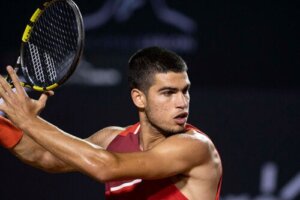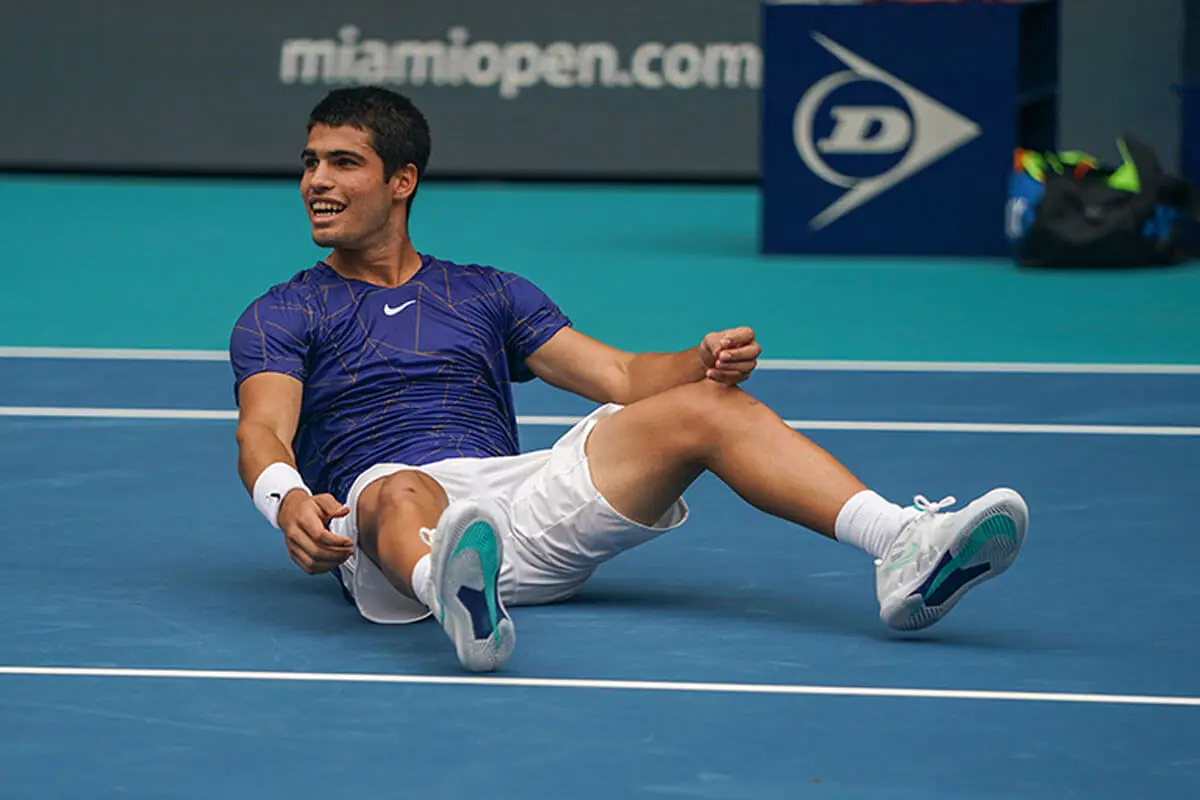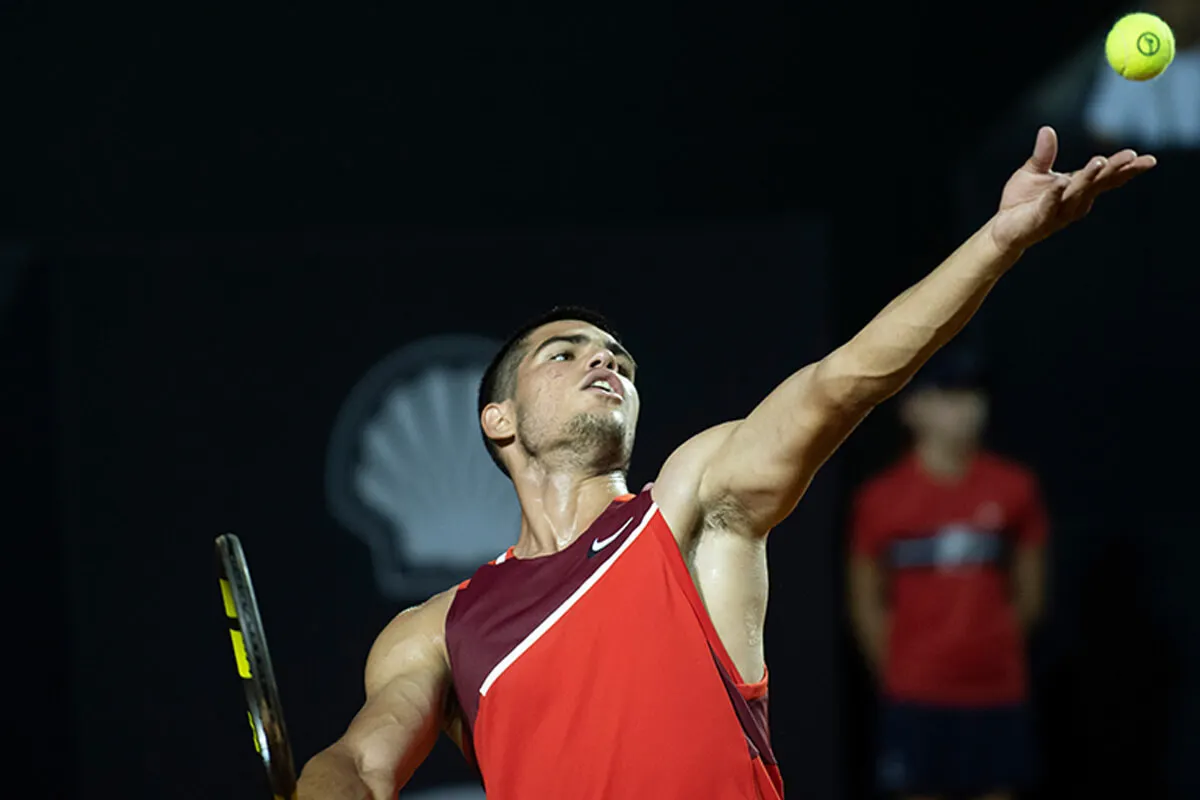How Carlos Alcaraz Trains Physically and Mentally to Win His Matches


Reviewed and approved by the doctor Leonardo Biolatto
Carlos Alcaraz is the number two Spanish tennis player in the world ranking; he’s currently competing in the Madrid Masters 1000. Since he first appeared on the sports scene, the young man has not stopped achieving professional success and stealing headlines thanks to his remarkable physical transformation.
At first, he had a very slim figure, but with time and a dedicated dedication to the sport, today he boasts incredible muscles. In this article, we’re going to tell you a little more about the work behind these results not only when it comes to his physical aspect, but also mentally.
What does Carlos Alcaraz’s physical preparation consist of?
Carlos Alcaraz is a native of El Palmar, a district of the region of Murcia, Spain. At only 19 years old, he established himself as one of the best tennis players in the world and one of the most coveted male players, although it was not always so.
Reaching the pinnacle of his career has cost him a lot of physical and mental effort.
He began training at a professional level at the age of 15, with the renowned trainer Juan Carlos Ferrero. Year after year, he has improved in every way. However, what’s drawn the most attention is his physical transformation, considering that one of his first nicknames was “spaghetti body”, due to his thinness and height.
183 centimeters is his height, according to the official ATP website.
The details behind this transformation came to light during the interview that the young tennis player gave to Men’s Health, a magazine he was on the cover of in 2022.

We think you may be interested in reading this, too: Novak Djokovic: All About His Training, Yoga, and Stretching Routine
“Entrenar cien por cien” (“Give it your 100%”)
“Carlitos,” as he prefers to be called, told the magazine that the secret behind his success is hard work:
The only secret is to work and take care of every detail on a daily basis. Rest, eat well, train one hundred percent…. The sum of all these elements is the key and, honestly, during these last two years, I’ve done everything better than ever.
On the other hand, his physical trainer, who knows him best, pointed out that the player’s body is the result of a lot of work. Although there is a genetic predisposition to respond well to training, 80% is effort.
The practice of a sport as integral as tennis, which requires the development of a sophisticated technique, has multiple benefits for muscle development. According to scientific articles, tennis players achieve outstanding aerobic fitness with a low percentage of adipose tissue.
This, together with a healthy diet, translates into a body with good lean mass. Likewise, the practice of tennis is directly associated with a much denser bone structure.
It must be said that, according to the Murcian, his training includes many hours in the gym. In short, he combines the technical with the aerobic and strength training.
Eating properly
In the words of Carlos Alcaraz, we find that food is key. And he’s absolutely right.
An article published in the journal Clinical Nutrition and Hospital Dietetics explains that the optimal performance of athletes depends on a proper nutritional approach. The dietary approach will have to correspond to the specific discipline being practiced.
A tennis player requires the consumption of carbohydrates, proteins, lipids (fats), and water. Many times, the decrease in performance is related to the depletion of energy substrates, dehydration, and fatigue.
The optimal quantity and quality of rest
When it comes to Carlos Alcaraz’s winning formula we find a very important variable: rest. It turns out that studies have determined that athletes require high-quality sleep for a greater number of hours than those who don’t practice any sport.
This is attributed to the restorative properties of sleep. The time of rest is the time for healing and building new muscle mass.
However, considering that athletes are at the mercy of competitions that often require changes in their schedule and travel between countries, they should include strategies to promote rest. Naps are one option. Also, maintaining proper sleep hygiene techniques is extremely important.
Like this article? You may also like to read: UFC World Champion Leon Edwards Shares His Workout Routine and Training Tips
Carlos Alcaraz, an exemplary iron mind

Carlitos is very young and is already ranked in the world top as a great tennis promise. Rubbing shoulders with other of the best and most experienced in his category, such as Rafael Nadal, has put a lot of weight on his shoulders.
If the mind isn’t focused, it’s impossible to concentrate on improving the game.
In this regard, Alcaraz confessed that he tries to work on mental control, as he’s sometimes come to think that he isn’t good enough on the court. He emphasizes that the fact of being focused throughout the game, and avoiding ups and downs, is crucial. And he must continue to improve this aspect.
These feelings don’t only afflict Alcaraz; it’s not in vain that there’s an entire branch of psychology dedicated to sports. This area deals with strategies that help athletes manage anxiety, self-esteem, confidence, and even motivation.
Experts explain that some of the pressures athletes must learn to deal with are the following:
- Pressure from their coaches;
- Pressure to achieve results;
- Pressure from their teammates;
- Social pressure from the public and their fans.
Finally, it’s also necessary to include the analysis of the movements and moves of the greatest players in the mental preparation of the Spaniard. This is done with the objective of creating a winning strategy of his own.
This preparation has helped Carlitos win his matches
Although he’s still very young, Carlos Alcaraz has given a lesson of commitment and discipline that’s giving great results. Apart from his excellent physical condition and the work he does on a mental level, his performance in every competition stands out, which leads him to be one of the best tennis players in the world.
What does the future hold for him? If he continues like this, there’s no denying the possibility of becoming a legend.
All cited sources were thoroughly reviewed by our team to ensure their quality, reliability, currency, and validity. The bibliography of this article was considered reliable and of academic or scientific accuracy.
- Fernández Fernández, J., Sanz, D., Fernández García, B., Terrados, N., & Méndez-Villanueva, A. (2009). Beneficios de la práctica del tenis sobre la salud (I). Arch. med. deporte, 382-386. https://pesquisa.bvsalud.org/portal/resource/pt/ibc-96246
- Jiménez, A. S., & Ariza, H. H. L. (2012). Psicología de la actividad física y del deporte. Hallazgos. https://revistas.usantotomas.edu.co/index.php/hallazgos/article/view/727
- Mata-Ordoñez, F., Bastos, P. C., Domínguez, R., & Sánchez-Oliver, A. J. (2018). Importancia del sueño en el rendimiento y la salud del deportista. e-Motion: Revista de Educación, Motricidad e Investigación, (11), 70-82. http://uhu.es/publicaciones/ojs/index.php/e-moti-on/article/view/3437
- Tavío, P., & Domínguez, R. (2014). Necesidades dietético-nutricionales en la práctica profesional del tenis: una revisión. Nutrición Clínica y Dietética Hospitalaria, 34(2), 18-28. https://medes.com/publication/93728
This text is provided for informational purposes only and does not replace consultation with a professional. If in doubt, consult your specialist.








